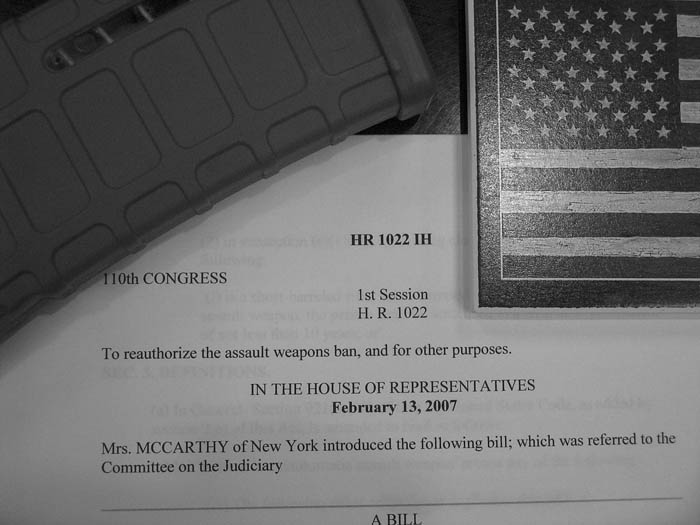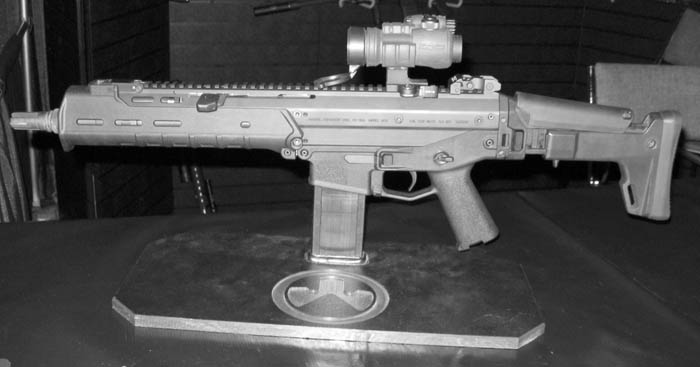By Jason R. Gillis
The National Defense Industrial Association’s (NDIA) President and CEO, LTG (Ret) Lawrence P. Farrell Jr., offered these intriguing thoughts when he rightly noted, “The small-arms sector is a critical component of the defense industrial base… The industry is small and somewhat fragile. To maintain its robustness, it sells products both to government and to commercial customers such as sportsmen and gun enthusiasts. To survive, the industry needs to make commercial sales, which provide a cushion between military orders.” These comments were published in 2002 in the article “Assault on the Small Arms Industrial Base. (President’s Perspective)” featured in the February issue of NATIONAL DEFENSE magazine. Now, seven years later and in a stormy political climate, those insightful words are as valid as the day they came off the press. But at the time there was little concern of any major legislation that would stifle the industry with only two years remaining on the 1994 Federal Assault Weapons Ban (AWB 94). After the ban expired it ushered in an abundant and progressive time for small-arms manufacturers that continues to this day, but the looming threats of new legislation are moving ever closer to reality and calls attention back to the integral relationship between the commercial and defense small-arms communities that Farrell touched on those years ago.
After the inauguration on January 20, one change we could believe in was espoused on the new White House website, online in minutes, and making clear the new President is not bashful regarding his intent concerning civilian firearms and the Second Amendment. In an effort to save the nation from gun violence in cities the administration has adopted a rather blunt stance:
“Obama and Biden would repeal the Tiahrt Amendment, which restricts the ability of local law enforcement to access important gun trace information, and give police officers across the nation the tools they need to solve gun crimes and fight the illegal arms trade. Obama and Biden also favor commonsense measures that respect the Second Amendment rights of gun owners, while keeping guns away from children and from criminals. They support closing the gun show loophole and making guns in this country childproof. They also support making the expired federal Assault Weapons Ban permanent.”


The idea of renewing the Federal Assault Weapons Ban in order to reduce violent crime is not a new or proven concept, but is certainly gaining ground in liberal circles. Besides a new government that is more inclined to such an agenda, events in places like Mexico are beginning to have a bearing on popular thought as Mexican authorities have asserted that U.S. commercial gun laws, not internal corruption, are the cause for their failure to wrestle control of the country back from the drug cartels. Even more so, lessons from Hurricane Katrina as well as grim prospects featured in congressional reports on the economy, electromagnetic pulse attacks, and bio-terror have all prompted further exploration into commercial firearms regulations and what role they may play in a future crisis.
The Missing X Factor
The controversy surrounding the renewal of an Assault Weapons Ban and other gun control legislation is not one that has been kept out of the public eye. It has been the focus of passionate articles, both pro and con, by the NRA and the Brady Campaign, newspaper editorials, independent studies, congressional reports, debates on The Hill, and as pointed out, the White House website. Questions regarding a future AWB and its relationship to the Heller decision were even raised by Sen. Tom Coburn during the confirmation hearing of Attorney General Eric Holder and placed before the world on C-SPAN. (AG Holder’s responses were not a surprise and consistent with his past record on the subject matter). With all of this attention it seems LTG Farrell’s observation that “The industry’s ability to make sales to commercial customers is critical to its survival” is an overlooked factor in the equation that has been either negligently, or in some cases dutifully, left out among most of the participants in the AWB issue. Arguably however, the most important question that can be asked in the debate is what effect will a new AWB have on the ability of the small arms industry to support the defense establishment and ultimately the warfighter and law enforcement officer (LEO)? A look into the controversy, with this question in mind, raises the alarm for both end users and those who supply them and suggests that the effort to promote awareness of this issue must be greatly increased before we are reeling with the blowback that inevitably comes with gun control legislation in the commercial market.

A Difficult Issue
An analysis of the effects civil legislation can have can only begin appropriately with a historical assessment of the past AWB implemented in 1994 and other commercial firearms legislation from the past. Ironically, the two major reports to stem from the ten hard years of the 1994 AWB, William Krouse’s CSR report, “Gun Control Legislation”, (Congressional Research Service, Updated 5 Sep 08, Order Code RL32842) and Christopher Koper’s “An Updated Assessment of the Federal Assault Weapon’s Ban; Impacts on Gun Markets and Gun Violence, 1994-2003” (with Daniel Woods and Jeffrey A. Roth, June 2004, Jerry Lee Center of Criminology) are virtually devoid of any useful information relating to an impact on national defense in spite of the important authoritative audience of the first report and the promising title of the latter. In fact, the further one investigates the interrelationship between the small arms defense industry and the commercial market it looks less like an unofficially neglected subject and more like an unofficially forbidden subject.
Why the apprehension to address this issue? There are several aspects that have affected open communication in this arena. It is unquestionable that the political and apolitical realms come to an unavoidable collision point any time gun control legislation and the controversy surrounding it is given a forum. As a result of this amalgamation, the reputable organizations that seemingly would tackle this subject become somewhat distant. The National Rifle Association for instance, though busy protecting the Second Amendment rights of Americans, would be outside of its normal function of representing the individual right to keep and bear arms by crossing into the arena of Defense lobbying. On the apolitical side, non-partisan defense associations can be skittish when toeing the line on a topic that has political ramifications that will impact their influence. Ironically, commercial legislation, whether it is federal or through international treaty through bodies like the U.N., may have more potential to rapidly destroy the small arms industry and have irreversible effects on the weapons that make it to the field than any other issue we are facing today.
The Present State
So is everything in the present healthy and conducive for happy coexistence of the military/LE and commercial markets? Undeniably no! Manufacturers have dealt with hundreds of pages of fine print that has run rampant since 1934 and reinforced in 1968 when the National Firearms Act (NFA 34) and Gun Control Act (GCA 68) came on the scene. It would take quite a large report, considerable time, and some good models to project just how severe the effect gun control legislation has been on our nation’s ability to produce more Hiram Maxims, John Brownings, Eugene Stoners, and “Carbine” Williams’ to put the best weapons in the hands of our warfighters. One could assume that these regulations would have a similar affect on the evolution of the classes of weapons they influence that new AWB would have.
The overly burdensome regulatory system itself is especially hard for the new designer, engineer, or manufacturer looking to build a reputation as the required (and increasing) licensing fees create severe monetary obstacles for those seeking to research and produce new weapons and accessories. Outside of BATFE requirements there is the constant plague of the ITAR (International Traffic in Arms Regulations), which requires all manufacturers of weapon related items to be registered with the State Department (DoS) by paying an annual fee of $2,250. Though all would agree with the need to keep secure our nation’s privileged defense information, the stipulations found in the ITAR often make common sense business principles that would not compromise national security impossible. The effect of the exuberant fee on small manufacturers for simple registration with DoS causes concern as well. “They’re taxing us right out of existence” noted one industry insider when citing the recent three fold increase in the filing fee. The industry still flourishes not because of, but in spite of, the myriad of laws and regulations in place; a credit to the American ability to adapt and overcome, not the efforts of the government to support a healthy small arms industry.
Laws meant for commercial gun control affect not only the development and manufacturing process, but also the availability of weapons and accessories in the Defense market and ultimately the end user. Since 1986, small arms providers adhering to 27 CFR 479.105(d) and ATF Rul 2002~5 have been forced to get end user sample letters from eligible organizations to get newly manufactured machine guns for demonstration purposes despite already being licensed and registered with BATFE and DoS for this business. Agencies, especially smaller law enforcement organizations, are often hesitant to provide the letters due to the discomfort of having the agency and authorizing officer’s name on a highly specific document related to a weapon they may not even commit to purchase. The letters require intensive detail and can be long in processing, while an agency wanting to have more than one weapon available for demonstration must submit excessive amounts of information to include the number of persons participating in the event, location, number of rounds to be fired, and any other reason they can find to justify why multiple demo weapons are necessary. For large organizations that want multiple weapons for demonstration, the weapon selection process may require several models or even multiple variants of the same weapon to be present which further complicates the acquisition. Providers on the other hand are unable to follow normal business practices applicable in most other businesses like purchasing samples for training, R&D, and marketing in order to gain customer interest in a particular product. Even worse, the sample weapons used for demonstration purposes currently cannot be transferred except under very limited circumstances and free market competition often grinds to a halt with frustrated organizations seeking providers who already have the samples they are looking for or settling for a weapon based on availability rather than optimal capability based on their specific needs. After the time, effort, and expenditure necessary in the current regulatory system, all in the name of commercial gun control, it is rather remarkable that the present state of affairs could be just the tip of the iceberg.
Even the wording of legislation can have unintended consequences on the user in harms way. 18 U.S.C. 925(d)(3) addresses importation of non-sporting firearms and reads, “In any case where the Attorney General has not authorized the importation of the firearm pursuant to this paragraph, it shall be unlawful to import any frame, receiver, or barrel of such firearms which would be prohibited if assembled.” With no clause for military and law enforcement included, the provision produced a mountain of frustration for select U.S. units using commercially available foreign alternatives to U.S. legacy systems. Despite the ongoing Global War on Terrorism, warfighters found they were unable to replace barrels on weapons currently in battlefield service, import barreled upper receivers for use with current issue lowers, or even import spare barrels for use with machine guns as per common practice. This lead to unwarranted logistical challenges placing some units in the awkward predicament of arranging critical parts shipments overseas to avoid importation. Ironically, federal, state, and local law enforcement agencies, to include the BATFE, found themselves in the same situation when attempting to import barrels for foreign weapons in common domestic use like the MP5 submachine gun. To the credit of the Federal Government, after three years of frustration and quagmire, the Department of Justice (DoJ) and the BATFE have made the changes needed and will now approve import applications for barrels and barreled upper receivers from military and law enforcement agencies. Despite the recent change, this is just a sampling of legal roadblocks that manage to hinder even the top tiers of our military and law enforcement agencies due to enforcement of short-sighted civil regulation.
The Rise and Potential Fall of Innovation
In November of 2008, the U.S. Army, after a year long controversy surrounding the M4 carbine, hosted an Industry Day based on a Request for Information concerning current small arms technology. In an unprecedented and historic turnout nineteen vendors responded with an overwhelming collection of products mostly developed since the sunset of the 1994 AWB in 2004. There were the usual large contractors that are part of the small-arms industrial base, but they accounted for a mere fraction of the vendors and technologies represented. Innovation from young companies, and some older ones with new focus, dominated the floor thanks largely to a healthy commercial firearms market. Since the expiration of the AWB, the number of companies manufacturing AR-15s and similar rifles has avalanched to a conservative estimate of thirty four, with even more producing accessories. Of these, a large number have active R&D programs offering unique products to the defense and LE markets.
The reason for such a historical pouring out of innovation can arguably be traced back to a decision based on the premise that the firearms industry could respond to any military requirements, to move away from the federal arsenal system and place more of the burden of designing and manufacturing military weaponry on firearms manufacturers “Historically, almost all of the major improvements in firearms since the closure of Springfield Armory have come from the Commercial/Military weapon manufacturers” points out John DeSantis, President of Bushmaster Firearms International. Bushmaster started life in the commercial firearms market and now offers a wide range of defense and LE related small arms from top quality production facilities. In the few short years since 2004, Bushmaster has expanded their product line well beyond the standard AR-15 type rifle to include calibers ranging from 5.56mm NATO to .50 BMG while maintaining an R&D and production capability that has made the company quite a competitor for major contracts. Even so, the flexibility when dealing with defense and LE products possessed by companies like Bushmaster is the benefit of a healthy commercial base which is currently thriving and allows for mutual gains to each market. According to DeSantis, “Many of the improvements and innovative designs were developed through their (Commercial/Military Small Arms Manufacturers) R&D efforts, which for the most part are fueled by the commercial market.” One of the more anticipated small arms present at the aforementioned Army Industry Day was the Adaptive Combat Rifle (ACR), which is moving towards commercial production with Bushmaster. Though offered by a large and prosperous company, the ACR began life at a smaller company, MAGPUL Industries, which has made a rapid rise otherwise unfeasible under AWB conditions.
MAGPUL is an impressive, but not uncommon, example of the importance of the interrelationship between the commercial and defense markets as it influences young expanding manufacturers. Though not officially at the Industry Day, the ACR presented by Bushmaster/Remington is clearly an evolution of the original MAGPUL Masada. Masada is the name referring to the location of a mass suicide of Jewish fighters defiantly facing the Romans and meant to convey the potential risk the small company was taking when embarking on the Masada project. In retrospect, the Masada has come to fruition and a little company that began by making plastic pull tabs for magazines has now pushed forward one of the most anticipated small arms designs on the market today.
But what makes this possible? What allows a young company like MAGPUL to rise from obscurity to be a real contender in the defense/LE industry offering new and innovative products without tapping tax payer money to do it? Interestingly, MAGPUL sources confirm that it is their highly successful commercial market based on collapsible butt stocks and hi-capacity magazines that provides them the flexibility to undertake projects like Masada and its 7.62mm counterpart Masood. Drake Clark of MAGPUL was quick to make the connection between innovation in the defense market and the expansion of the commercial market. “Everyone I’ve talked to on high levels agree with the assessment that innovation skyrocketed overnight” he said referring to the sunset of the 1994 AWB. “The refueling of the black rifle market has dumped money into those products and answers a thirst that allows companies like us to develop and innovate. The PMag (a hi-capacity magazine for the AR-15/M16 type rifle) is our flagship product and certainly contributes to funding the military side. It allows revenue for new products to include rifles.” When asked about the affects on their defense product development and production if faced with the resurrection of a ban on manufacturing weapons with collapsible stocks and hi-capacity magazines for commercial consumption, the answer was clear: “Impact on funding as it goes toward defense products would be immense.”
VLTOR Weapons Systems, which offers a similar line of enhanced accessories for commercial “black” rifles, expressed similar concerns regarding the affect a ban may have on the company’s ability to develop products for military and law enforcement agencies. According to General Manager Eric Kincel, “Collapsible stocks are our flagship product line… A surprisingly large amount of R&D comes from commercial sales, nearly all to be honest.” VLTOR emerged during the years of the last ban and though successful, the company understands the difficulties such an environment brings to the table and Kincel gave some insight on other challenges faced under ban-type conditions. “Our collapsible stock system is one of our cash cows. We adapted to the ban by offering fixed stock alternatives. By having no ban we are able to focus more on product that would better suit the military market, which can be sold to the civilian market as well. By focusing on pre-ban weapons only, our R&D budget is concentrated on one market, which is easier to plan for future weapons development.”
Other factors influence the defense market for smaller companies besides the influx of commercial cash. For instance the MAGPUL PMag has had significant law enforcement and military success, with some 500,000 in circulation in those roles, due in large part to their availability on the commercial market. Private purchases by warfighters and LEOs serve as a great T&E tool and often a product’s successful exposure commercially is what ushers it in to consideration for use by the military services or an agency. Further complicating matters is the trickle down effect on production seen when suppliers dry up due to banning of their products. MAGPUL and VLTOR both have seen significant use of their enhancements on factory weapons coming from other manufacturers, a condition that would surely suffer in the face of new legislation. Keep in mind that these companies are but a sampling of a larger body of similar interrelated companies that offer a world of enhanced weapons and accessories facing the same circumstances.
Facing the Challenge
Certainly the landscape that faces the small arms industry in today’s political climate is much rockier than that of the past eight years. The gun control agenda of some is so fervent that it has lead to some creative methods of attacking the small arms industry to include proposed bans on common types of ammunition to heavy taxation that would reduce demand through expense and cripple production. As a whole, the 1994 AWB had one saving grace about it; the provisions allowed compliant versions of weapons like the AR-15 to continue in commercial production. Even before the sunset of the AWB in 2004, groups like the Violence Policy Center began the process of collecting data and informing politicians just how to avoid “post ban” weapons in the future. As a result of these efforts, bills like H.R. 2038 (May 03), H.R. 1022 (Feb 07), and H.R. 6257 were introduced to incorporate increased restrictions aimed at eliminating the post ban concept all together. Some of the worst provisions have gone as far as to present language that would in effect eliminate any firearm or copy of a firearm, regardless of configuration, in use by the military or law enforcement for commercial consumption while others have sought to eliminate manufacture of commercial frames/receivers for banned weapons. Either stipulation if incorporated into law would virtually shut down U.S. production for any supplier who did not have contracts in place. Today, legislative bills that have stalled in the past face new prospects for passage and support from powerful and zealous anti-gun supporters. Those small arms manufacturers and suppliers that survived the last ban by American ingenuity may find it much more difficult to keep afloat if new legislation is implemented. One insider from a major manufacturer summed up the potential result for the defense community rather candidly when he noted referring to small-arms, “If these things go forward we might as well look to the Europeans for our needs.” John Desantis on the other hand brought a comment to the table that cuts to the very heart of the issue and revisits the main point, “I am not sure the American public or the people in the House and the Senate really understands the full implications of a total assault weapons ban.”
So what can be done about the issues we face concerning our civil firearms legislation and its relationship to our country’s defense? Identifying the problem, that there is a wall erected between the two markets in the eyes of those outside of the industry, is the first step. Breaching that wall without fear of reprisal is certainly a more difficult but highly important follow-on task. The gap has to be bridged so that when new legislation is introduced it is done with the full picture of our national interest, not simple and narrow social agendas. Perhaps associations will emerge that are unafraid of a little backlash for delivering the truth no matter how harsh it shakes political ambitions. Perhaps more people will speak out as LTG (Ret) Farrell did when he stated NDIA’s intentions in his article, “Our goal is just to make sure that the industry remains viable so it can supply our military forces with the needed weapons.” Certainly, at a minimum, manufacturers of defense firearms, whether they have major contracts or not, with a unified and authoritative voice should make known the major decline in industry capability and innovation our country will face if we commit national suicide with our own small-arms industry. If there is a failure to react to the very legitimate concerns of regulatory excess, we may be faced with a firearms industry that can not produce the MAGPUL/Bushmaster/Remington partnerships to bring an innovative new rifle into the market. We may even find a decline in R&D and production that may stagnate and defeat U.S. small arms producers in the face of foreign competitors as seen in the auto industry. Even today, as this article prepares for press, the interviews and research this writer has performed make one hopeful that these ideas are starting to take root. Awareness is spreading, and those who have the ability to make these concerns known have committed to the effort of disseminating this information not for the good of our own pockets and gun safes, but for our brave men and women who utilize small arms as a primary tool to defend our nation and uphold the rule of law across the free world.

| This article first appeared in Small Arms Review V12N9 (June 2009) |











